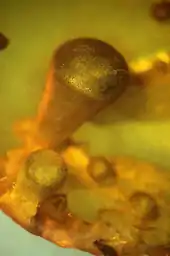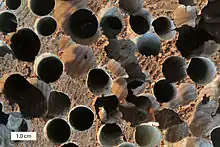Teredolites
Teredolites is an ichnogenus of trace fossil, characterized by borings in substrates such as wood or amber.

Teredolites clavatus in Burmese amber

Teredolites; an ichnogenus formed by boring bivalves in wood.
Club-shaped structures rimming mid-Cretaceous Burmese amber were formerly identified as the fungal sporocarps Palaeoclavaria burmitis. a 2018 study re-identified the structures as domichnia (crypts) bored in the amber nodules by bivales of the pholadid subfamily Martesiinae. The borings are comparable with Teredolites clavatus and Gastrochaenolites lapidicus .[1] Due to the substrate of the Myanmar borings being amber, the term Amberground was coined.
See also
References
- Smith, R. D. A.; Ross, A. J. (2018). "Amberground pholadid bivalve borings and inclusions in Burmese amber: implications for proximity of resin-producing forests to brackish waters, and the age of the amber". Earth and Environmental Science Transactions of the Royal Society of Edinburgh. 107 (2–3): 239–247. doi:10.1017/S1755691017000287.
This article is issued from Wikipedia. The text is licensed under Creative Commons - Attribution - Sharealike. Additional terms may apply for the media files.
